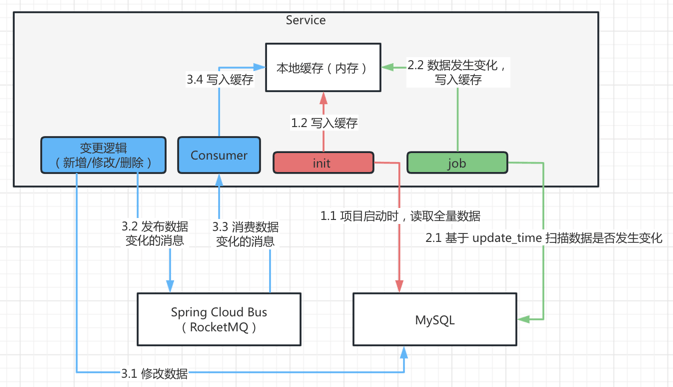 本地缓存
本地缓存
重要说明:
① 由于大家普遍反馈,“本地缓存”学习成本太高,一般 Redis 缓存足够满足大多数场景的性能要求,所以基本使用 Spring Cache + Redis 所替代。
也因此,本章节更多的,是讲解如何在项目中使用本地缓存。如果你不需要本地缓存,可以忽略本章节。
② 项目中还保留了部分地方使用本地缓存,例如说:短信客户端、文件客户端、敏感词等。主要原因是,它们是“有状态”的 Java 对象,无法缓存到 Redis 中。
系统使用本地缓存,提升公用逻辑的执行性能。 例如说: *
- 租户模块 (opens new window) 缓存租户信息,每次 RESTful API 校验租户是否禁用、过期时,无需读库。
- 部门模块 (opens new window) 缓存部门信息,每次数据权限校验时,无需读库。
- 权限模块 (opens new window) 缓存权限信息,每次功能权限校验时,无需读库。
# 1. 实现原理
本地缓存的实现,一共有两步,如下图所示:

- 项目启动时,初始化缓存:从数据库中读取数据,写入到本地缓存(例如说一个 Map 对象)
- 数据变化时,实时刷新缓存:(例如说通过管理后台修改数据)重新从数据库中读取数据,重新写入到本地缓存
# 2. 实战案例
以 角色模块 (opens new window) 为例,讲解如何实现角色信息的本地缓存。
# 2.1 初始化缓存
① 在 RoleService (opens new window) 接口中,定义 #initLocalCache() 方法。代码如下:
// RoleService.java
/**
* 初始化角色的本地缓存
*/
void initLocalCache();
为什么要定义接口方法?
稍后实时刷新缓存时,会调用 RoleService 接口的该方法。
② 在 RoleServiceImpl (opens new window) 类中,实现 #initLocalCache() 方法,通过 @PostConstruct 注解,在项目启动时进行本地缓存的初始化。代码如下:
// RoleServiceImpl.java
/**
* 角色缓存
* key:角色编号 {@link RoleDO#getId()}
*
* 这里声明 volatile 修饰的原因是,每次刷新时,直接修改指向
*/
@Getter
private volatile Map<Long, RoleDO> roleCache;
/**
* 初始化 {@link #roleCache} 缓存
*/
@Override
@PostConstruct
public void initLocalCache() {
// 注意:忽略自动多租户,因为要全局初始化缓存
TenantUtils.executeIgnore(() -> {
// 第一步:查询数据
List<RoleDO> roleList = roleMapper.selectList();
log.info("[initLocalCache][缓存角色,数量为:{}]", roleList.size());
// 第二步:构建缓存
roleCache = CollectionUtils.convertMap(roleList, RoleDO::getId);
});
}
疑问:为什么使用 TenantUtils 的 executeIgnore 方法来执行逻辑?
由于 RoleDO 是多租户隔离,如果使用 TenantUtils 方法,会导致缓存刷新时,只加载某个租户的角色数据,导致本地缓存的错误。
所以,如果缓存的数据不存在多租户隔离的情况,可以不使用 TenantUtils 方法!!!!
# 2.2 实时刷新缓存
为什么需要使用 Spring Cloud Bus (opens new window) 来实时刷新缓存?考虑到高可用,线上会部署多个 JVM 实例,需要通过 RocketMQ 广播到所有实例,实现本地缓存的刷新。

友情提示:
对 Spring Cloud Bus 不熟悉的同学,可以后续阅读 《芋道 Spring Cloud Alibaba 事件总线 Bus RocketMQ 入门 》 (opens new window) 文档。
# 2.2.1 RoleRefreshMessage
新建 RoleRefreshMessage (opens new window) 类,角色数据刷新 Message。代码如下:
@Data
public class RoleRefreshMessage extends RemoteApplicationEvent {
public RoleRefreshMessage() {
}
public RoleRefreshMessage(Object source, String originService, String destinationService) {
super(source, originService, DEFAULT_DESTINATION_FACTORY.getDestination(destinationService));
}
}
# 2.2.2 RoleProducer
① 新建 RoleProducer (opens new window) 类,RoleRefreshMessage 的 Producer 生产者。代码如下:
@Component
public class RoleProducer extends AbstractBusProducer {
/**
* 发送 {@link RoleRefreshMessage} 消息
*/
public void sendRoleRefreshMessage() {
publishEvent(new RoleRefreshMessage(this, getBusId(), selfDestinationService()));
}
}
② 在数据的新增 / 修改 / 删除等写入操作时,需要使用 RoleProducer 发送消息。如下图所示:

# 2.2.3 RoleRefreshConsumer
新建 RoleRefreshConsumer (opens new window) 类,RoleRefreshMessage 的 Consumer 消费者,刷新本地缓存。代码如下:
@Component
@Slf4j
public class RoleRefreshConsumer {
@Resource
private RoleService roleService;
@EventListener
public void execute(RoleRefreshMessage message) {
log.info("[execute][收到 Role 刷新消息]");
roleService.initLocalCache();
}
}
